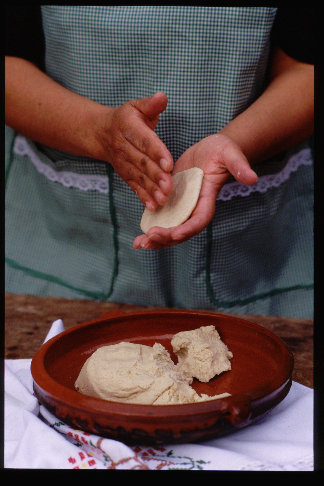
Photo Laurie Smith
Many centuries ago, Mexican cooks discovered that as good as corn is when eaten fresh or dried, it takes on an exciting new identity when treated with a solution of wood ashes, burnt seashells, or some other natural alkali. The process is called nixtamalización. Nixtamal, the resulting hominy-like product, is valuable both for nutritional reasons (some important nutrients are more available than in plain, untreated corn), and for the unique flavor that the kernels develop. If you taste Mexican tortillas or tamales side by side with some of the similar corn dishes from other Latin American countries where the nixtamal process is not used, you’ll recognize the difference. Compared with the haunting, penetrating, but subtle flavor and aroma of nixtamalized corn, something seems to be missing.
Making nixtamal at home at least once is worthwhile if only to see how simply corn is magically transformed into the foundation of the Mexican corn kitchen. The usual alkali today is cal, or calcium hydroxide. It can be ordered from drugstores by the ounce as “slaked lime.” In New York you can get it at Tortilleria Nixtamal.
Check out my comprehensive article on corn, In Mexico: Corn is Life, on The Daily Meal. Also watch my videos on making tamales and other corn products.
Nixtamal
Yield: About 3-3½ pounds (7-8 cups)
2 pounds dried dent corn or starchy blue corn kernels
3 quarts water
¼ cup cal (slaked lime; see above)
Place the corn in a colander and rinse under cold running water to wash off the dusty chaff. Combine the water and cal in a large nonreactive saucepan. Stir well to dissolve and add the corn, discarding any kernels that float.
Bring to a boil over high heat, then reduce the heat to low. The corn will be noticeably yellow (even blue corn will turn somewhat yellowish). Cook for 15 minutes, remove from heat, and let cool to room temperature. Let the corn soak, covered, for 4 hours at room temperature or overnight in the refrigerator. The kernels will now be visibly softened and swelled.
The last step is to remove the outer skins, now soft and gelatinous. Pour the contents of the saucepan into a large colander and rinse thoroughly under cold water. With the cold tap running, rub the kernels between the palms of your hands until the last gelatinous coating rinses off to reveal the kernel and corn germ (the inset pointed tip, which Mexicans often remove but I usually leave intact). When the coating is completely gone, thoroughly drain the nixtamal. It is now ready to use.
Nixtamal does not store well. It will keep, tightly covered, in the refrigerator for 2 or at the outside 3 days. If not using the full amount at once, freeze the surplus. It will keep for up to 3 months.
(I like to cook the kernels in chicken stock until they pop open like flowers and eat the soup on a cold winter night.)
Masa (Treated Corn Dough)
In the Mexican kitchen, masa (Spanish for “dough”) is what you get by grinding fresh nixtamal into a mass. When I say that Veracruzan corn dishes are incomparable, masa is the most crucial thing I can think of. With no added fancy ingredients, the corn has such pure and good flavor that you can find yourself relishing the dough for its own sake.
The number of things you can do with masa is infinite. It can be thinned to make a drink (atole de mora). As a thickener, it lends wonderful flavor while binding soups or sauces. It makes delicious dumplings — the bolitas de masa should be tried by any dumpling fan. Masa-based tortillas are a fascinating family ranging from the Tortillas de Masa y Plátano Verde, Gorditas de Infladas, Pellizcadas, and Enchiladas Huastecas. Masa can serve as wrapping, shell, or base for any sort of filling and topping. This is how you encounter it in innumerable street snacks — the smaller fried shells called garnachas de masa cocida, or the simple empanadas made by folding a tortilla in half to wrap a filling.
Good masa is an indispensable ingredient for exploring Veracruzan cuisine. How do you obtain it in this country? I think most people would be wise to look for a tortilla factory — it’s surprising how many turn up in local phone books across the country — and try to order it fresh-ground. If no tortilla factory exists anywhere near your home, check at your local Whole Foods! It was just announced that they are starting to use native Mexican corn, specifically Oaxacan corn. I don’t know the details yet, but here is an article.
I have tried masa from many different U.S. suppliers and usually find it good rather than superlative. The true, deep corn taste of Veracruzan masa isn’t quite there. When the masa has to be thinned, I almost always use homemade chicken stock instead of the more authentic water to try to boost the flavor, but it’s not a perfect solution.
There are two alternatives to U.S. tortilla-factory masa. One is dehydrated powdered masa, often sold as masa harina. (Never confuse it with U.S. cornmeal, which is absolutely unacceptable!) It comes in 2- and 5-pound bags and has to be reconstituted by being mixed to a paste with liquid — again, I prefer chicken stock for extra body and flavor. Rehydrated masa harina is not as good as real masa, but I find it acceptable in all but a few cases. The brand I prefer is Maseca. However, Quaker masa harina is more widely available and can be ordered through any supermarket that carries Quaker cereals.
The basic technique of reconstituting masa harina is always the same, though the proportion of liquid may vary from recipe to recipe. Place the masa harina in a large mixing bowl and work in slightly warm water or stock with a wooden spoon or your bare hands until you have a fairly stiff dough — a little softer for tamales and firmer for tortillas. The exact amount of liquid needed tends to fluctuate from batch to batch.
The other possibility is to grind your own masa from homemade nixtamal. For centuries this was the only way of making masa in Mexico. People did it at home kneeling on the floor in front of the immemorial volcanic rock metate — a real Stone Age process that some people still use for small quantities when they want a particular consistency. But most cooks in Oaxaca now take their nixtamal to a local mill to be custom-ground (unless they buy fresh masa already ground to order). I have experimented with different home methods, and to my dismay they either didn’t work or were nearly as grueling as bending over the metate! The problem is that the nixtamalized corn has enough starch to gum up most devices.
The food processor gave a very poor consistency. I tried the grain-grinding attachment of my KitchenAid electric mixer and can’t recommend it — the attachment, actually intended for dry grains, works after a fashion, but it is very slow going. However, I did get a letter from a reader who uses the meat grinding attachment of his KitchenAid and has had excellent results. Another solution I suggest if you passionately desire to grind your own masa is a hand-cranked, tinned cast-iron corn mill from South America that clamps onto a table and can be adjusted to coarser or finer grinds. As a general rule of thumb, coarsely ground masa is best for tamales, finely ground for tortillas and most other purposes such as thickening sauces. Keep the distinction in mind if ordering dough from a tortilla factory.
Grinding with the mill is also difficult and time consuming, but it is more efficient than the KitchenAid. I am giving directions for this method for the benefit of those who absolutely have to try everything by hand at least once, but I have to say that its practical uses are limited. To grind even 1 pound of nixtamal into masa can take close to 1 hour. It would have a definite advantage over buying factory masa only if you had access to some unusually good strain of corn.
Masa Molida a Mano (Hand-ground Masa)
Yield: Slightly more than 1 pound (about 2½ cups) masa
1 pound (about 4 cups) well-drained nixtamal (see above)
Water as necessary
Clamp the grinder firmly to a tabletop or counter with a plate or bowl under the grinding plates. Adjust the distance of the plates (by the calibration on my Universal grinder, set at 3 for a fine and 5 for a coarse grind). Begin feeding handfuls of nixtamal into the hopper of the machine while turning the handle. Push down firmly with your hand to keep the kernels going in.
When all the corn is ground, gather up a handful between your fingers to judge the consistency. The ground nixtamal usually requires some water to form a proper dough. Add 2-3 tablespoons of water at a time, working the masa with your hands or a wooden spoon, until the mixture holds together well and is the consistency of a stiff cookie dough. The amount of water needed may be ½ to ⅔ cup.
NOTE: Whether homemade or bought from a factory, fresh masa should be used quickly. Store in the refrigerator, tightly wrapped, for up to 2 days; freeze any unused portion. I find that masa for tortillas freezes less successfully than that for tamales.

